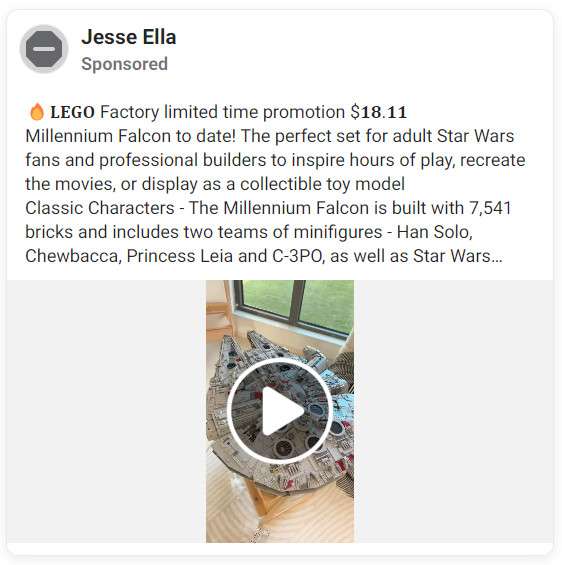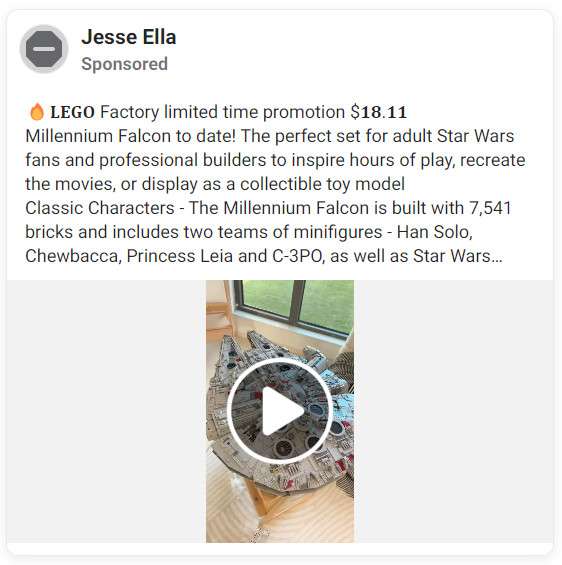Imagine seeing an ad for the iconic LEGO Star Wars Millennium Falcon set priced at just $18.11. As a dedicated LEGO fan, scoring this $500 kit for over 90% off would be a dream come true! But before smashing that Buy button, beware – unbelievably cheap LEGO deals online are often too good to be true.

The LEGO Millennium Falcon Scam Overview
Fraudsters are running elaborate fake LEGO sales on social media and shady websites, duping customers into paying for sets that never ship. A common lure is advertising the coveted Millennium Falcon for around 95% off retail value. Let’s dive into how this deception works and make sure your next LEGO purchase doesn’t leave you brick broke.
These LEGO scams typically begin with social media ads promoting unbelievable discounts on expensive sets like the Millennium Falcon. The ads are carefully designed to target loyal LEGO fans who would be highly motivated by the prospect of scoring pricey kits for pennies on the dollar.

The fraudulent ads feature tantalizing headlines like:
- “🔥 Today Only – Millennium Falcon – 95% Off!”
- “LEGO Factory Sale – Millennium Falcon Just $18.11!”
- “⚡Don’t Miss Out! Retired Millennium Falcon – Now Only $29🔥”
The posts also leverage false scarcity and urgency tactics, such as “limited time offer” or “going fast!”, to convince potential victims they must act quickly before the fictional promotion ends.
To appear credible, the scam Millennium Falcon ads utilize official LEGO product imagery and even incorporate the LEGO logo. For the unaware, they give the false impression that LEGO is directly behind the promotions.
In reality, these ads have absolutely no connection to the LEGO Group whatsoever. Scammers simply use the popular LEGO brand illegally to perpetrate their fraud.
When victims click on the fraudulent social media ads, they are redirected to elaborate scam websites that continue the ruse. These fake LEGO webstores feature deep discounts on the Millennium Falcon and other popular LEGO sets. The goal is to dupe shoppers into believing they are purchasing authentic LEGO sets for 80-95% off real prices.
To increase credibility, the scam sites sometimes list phone numbers, physical addresses, and customer service email addresses. However, these contact details are fake and tracing them leads to dead ends.
After luring victims in with social media bait and convincing fake websites, the scammers collect payment information through integrated payment processors like PayPal, Stripe, and Square. This builds additional trust, since customers assume no legitimate payment company would work with a fraudulent seller.
In reality, the scammers simply setup payment processing just like any digital business could. The scam works because once payments are collected, no LEGO sets are ever shipped. The criminals disappear with the payments and are virtually untraceable.

Customers who fell for the ruse never receive the deeply discounted LEGO Millennium Falcon they ordered. Any shipment that eventually shows up contains an inferior knockoff product, something random like a $1 bracelet, or nothing at all. This prevents payment processors from quickly realizing a scam took place.
The LEGO scam takes advantage of passionate fans who would be strongly motivated by the prospect of acquiring the expensive Millennium Falcon for 80-95% off retail value. The ads and websites initially seem authentic to the unaware.
By the time victims realize they’ve been defrauded, the fake websites have vanished and the criminals are long gone with their money. Customer payments are gone as well, with virtually no way to receive refunds or recover lost funds.
This devastating scam has played out across social media and legitimate online marketplaces repeatedly. Aspiring LEGO builders of all ages have been duped while attempting to score an amazing deal on this top-tier set. Even experienced LEGO collectors can be deceived if they don’t look closely for warning signs.
The LEGO Group advises customers only purchase LEGO products through authorized retailers. If a deal seems unrealistic, it undoubtedly is. LEGO sets rarely go on extremely deep discount legitimately.
With the LEGO brand being so iconic and beloved, scammers will continue creating increasingly elaborate scams to cash in on that popularity. Stay vigilant and think twice before entering payment information, no matter how unbelievable the supposed LEGO deal is.
How the Fake LEGO Millennium Falcon Sale Scam Works
The criminals running these fake LEGO sales have developed a devious process to successfully separate trusting fans from their money. Here is how the scam typically operates step-by-step:
1. Bait Social Media Ads
The scammers create social media ads on platforms like Facebook, Instagram and TikTok announcing a super-discounted LEGO Millennium Falcon set for around $18-$29. The ads claim to be a special factory sale or warehouse clearance event with prices up to 95% off.
They incorporate real LEGO set photos and legitimate branding elements that appear convincingly authentic. The ads target users who engage with LEGO fan pages and interest groups.
2. Drive Traffic to Fake Website
When users click on these social media LEGO ads, they are funneled to an elaborate fake website set up by the scammers. This site shows incredibly cheap prices for the Millennium Falcon and other LEGO sets.
The website is designed to look like an authentic LEGO retailer or distributor, featuring LEGO’s trademarks, logos, and product imagery. However, the domain name will be unrelated to LEGO.
3. Build False Trust and Urgency
To prevent suspicion, the fake sites utilize various trust-building elements and sales tactics:
- Major payment processor integration like PayPal or Square
- Fake physical addresses and customer service contacts
- Countdown timers or claims of limited quantities to create false urgency
- Reviews and testimonials completely fabricated by the scammers
- No obvious grammatical errors or other warning signs of a scam
This convinces customers they are dealing with a legitimate retailer offering an authentic sale.
4. Collect Payments
Once users are hooked, the scammers collect payments through the integrated payment processors. Customers enter credit card or other payment details, assuming the transaction is secure and legitimate.
In reality, the criminals are simply leveraging payment processing services just like any real online business could. Their only goal is capturing victim’s money, not actually shipping LEGO sets.
5. Disappear and Leave Customers Empty-Handed
With payments collected, the scammers disappear. They shut down the website, abandon email addresses, and disconnect phone numbers. No Millennium Falcon sets or other LEGO products are ever shipped.
Most victims don’t realize they’ve been scammed for weeks or months. The criminals make off with the money virtually untraceably. Customers have no recourse to recover lost funds or receive the LEGO sets they ordered.
By following this detailed process, LEGO scam artists are able to repeatedly trick fans who are eager for deals on expensive kits like the Millennium Falcon. Stay vigilant and avoid taking a chance on deals that sound too good to be true.
How to Identify Fraudulent LEGO Sale Websites
Skilled scammers are adept at creating convincing fake LEGO retailer websites to lure deal seekers. But upon closer inspection, these scam sites generally share common red flags:
Recently Registered Domains
Fraudulent LEGO sale sites tend to use recently registered domains instead of established sites. Search the domain on WHOIS database sites to view the creation date. Authentic retailers will have domains registered for many years.
Missing Contact Information
Scam websites lack legitimate physical addresses and phone numbers. They only provide email addresses which are later abandoned after collecting payments.
Unrealistic Discounts and Deals
Fake LEGO sites advertise prices like 90% off along with other unrealistic promotions like “Clearance Sale” or “Going out of Business Sale”. Authentic LEGO sellers do not offer such steeply discounted brand new sets.
Plagiarized Site Design and Content
Scam websites typically feature copied content, product imagery, and web design templates to appear more legitimate. But the low quality plagiarized elements are noticeable on closer inspection.
Stock Images Instead of Original Photos
Fake LEGO websites rely heavily on stealing official LEGO product stock photos instead of having unique in-house product photography. Authentic retailers’ sites display many original photos.
Poor Quality Images
Along with stock photos, scam websites often contain amateurishly edited images with watermarks cropped out, low resolutions, and sloppy photo editing errors.
Grammatical Errors
Fraudulent sites tend to contain many typos, grammar mistakes, and awkward phrases within product listings and other site content. Authentic retailers have proper copy editing.
Too Good to Be True Prices
Listings on scam LEGO sites will boast prices that are simply unrealistic. Authentic retailers cannot offer brand new sealed LEGO sets for 70-90% below retail value.
High-Pressure Tactics
Fake LEGO websites apply tactics like countdown timers and claims of low stock to pressure customers into purchasing quickly before scrutiny can set in.
No Secure Checkout Process
Scam LEGO retailers lack the encrypted HTTPS secure checkout processes used by all legitimate online stores. Any site only offering unsecured purchase pages should be avoided.
Examining LEGO sale sites carefully for these warning signs makes it possible to identify and avoid scams. Stick to authorized retailers like Amazon, Walmart and LEGO.com for guaranteed authentic LEGO sets without being ripped off.
How to Identify Fake LEGO Sales on Social Media
Skilled scammers leverage popular social platforms to advertise their fake LEGO sales and lure victims. Here are tips for spotting fraudulent LEGO deals on Facebook, Instagram and TikTok:
Watch for Facebook ads or posts with:
- Too good to be true prices (90%+ off retail)
- High pressure slogans like “Limited Time Only!”
- Suspicious or sketchy Facebook pages promoting the deals
- Comments disabled on the posts to hide negative feedback
- Links leading to unrelated or sketchy external websites
Example:
An ad for the $500 Millennium Falcon discounted to $29 should raise immediate red flags, especially if posted by a page created last week you’ve never heard of.
Look out for Instagram posts with:
- Exaggerated discounts of 70%+ off MSRP in the caption
- Aggressive captions urging fast action before the sale ends
- The @ username or linked profile seems unrelated to LEGO
- Low follower count or recent account creation date
- Links in bio sending to sketchy deal websites
Example:
A post from @legosale2022 claiming “Going out of business – All sets 70% off!” is a major warning sign coming from a 2-week old account.
TikTok
Be suspicious of TikTok videos promoting:
- Millennium Falcon for $19 or similar too cheap to be real prices
- High-pressure captions to take advantage of the deal immediately
- Questionable links in profile bios
- Brand new accounts with minimal followers and engagement
- Comment sections disabled to prevent negative feedback
Example:
A TikTok user named @legofactoryblowout posting a video claiming “Retiring sets closeout sale – 75% off!” should not be trusted or clicked on.
Always scrutinize social media LEGO promotions carefully. Seemingly great deals often hide deceptive scams just wanting your money and data. Only shop with reputable sellers and authorized LEGO retailers for genuine discounts.
What to Do If You’ve Fallen Victim to the Fake LEGO Millennium Falcon Sale Scam
If you unfortunately fell for one of these fraudulent LEGO sales and purchased a deeply discounted Millennium Falcon set that never arrived, here are important steps to take:
1. Contact your payment provider immediately.
Notify your credit card company or payment processor like PayPal that the charges were deceptive and unauthorized. Request an immediate chargeback and provide details on the scam website. This can potentially help recover lost funds.
2. Report online scam payment transactions to the FTC.
File a complaint with the Federal Trade Commission’s online reporting tool detailing the LEGO scam purchase and website information. This helps authorities track and build cases against prolific scam operators.
3. Watch for additional suspicious charges.
Monitor your credit card and bank account closely for any other unusual charges by the scammers. They may attempt smaller “test” charges you could miss. Identify these quickly and report them.
4. Reset passwords on compromised accounts.
If you used the same password on the scam site as other accounts, change your passwords immediately. Scammers who obtain password information may attempt to access your other online accounts.
5. Beware of recovery scams.
You may be targeted again by “recovery” scammers falsely claiming they can help obtain refunds for an upfront fee. Avoid engaging with these individuals – they are attempting another scam.
6. Report the fake website if still active.
If the scam LEGO website is still accessible, report it to the hosting provider, registrar, and any abuse channels available. Getting fraudulent sites shut down can protect other users.
7. Leave online warnings about the scam.
Wherever you first saw the fake LEGO Millennium Falcon sale advertised, leave comments warning others it is a scam. This helps prevent the criminals from victimizing more innocent LEGO fans.
8. Only buy LEGO sets from trusted retailers.
In the future, only purchase LEGO products through authorized retailers like Amazon, Walmart, Target and the official LEGO website. Sets rarely go on significant discount legitimately.
9. Learn the warning signs of scams.
Study scam techniques like pressure tactics, unbelievable prices, fake contacts and reviews. This knowledge helps you identify and avoid LEGO scams moving forward. Avoid making quick impulse purchases.
10. Be extra vigilant with online marketplace sellers.
Exercise caution when buying LEGO sets from Facebook Marketplace, Craigslist, eBay, or Instagram sellers. Require strong seller rating histories before transacting.
With awareness and caution, LEGO enthusiasts can continue enjoying the hobby while sidestepping these sophisticated scammers waiting to capitalize on deal-seekers. Don’t let a single scam experience deter you. Just approach future sales smartly and protect your payments.
Frequently Asked Questions About the Fake LEGO Millennium Falcon Sale Scam
1. What is the fake LEGO Millennium Falcon sale scam?
This scam involves advertisements on social media and websites promoting the expensive Millennium Falcon set for up to 95% off MSRP. The goal is luring LEGO fans to fake webstores that steal payment information and ship nothing.
2. How does the LEGO Millennium Falcon scam work?
- Criminals bait fans with social media ads for the Falcon at absurdly cheap prices
- Victims click the ads and are sent to elaborate fake webstores
- These sites use trust tactics to convince shoppers the “deals” are real
- Scammers collect payment information through integrated processors
- No LEGO sets ship and the criminals disappear with the payments
3. What prices are used in the Millennium Falcon scam ads?
The ads typically list the $500 set for $18, $29, or similar 80-95% discounts. This motivates fans to click and purchase quickly before examining closely.
4. Are the scam websites easy to identify as fake?
The criminals work hard to make their sites look real. But flaws like recent domains, fake contact info, and plagiarized content can reveal frauds.
5. Can I get scammed buying LEGO sets from Amazon or other major retailers?
No. Amazon, Walmart, Target and LEGO.com are authorized sellers. Scams only occur on sketchy independent websites.
6. What should I do if I already purchased from a scam Millennium Falcon sale?
Immediately contact your payment provider to attempt a chargeback. Report the scam to the FTC. Reset any compromised account passwords. Monitor statements for further fraud.
7. How can I avoid the Millennium Falcon scam in the future?
Only buy directly from LEGO and authorized major retailers. Research unfamiliar sellers thoroughly first. Beware unbelievable prices like 90% off.
8. Are other LEGO sets used in similar scam promotions?
Yes, scammers run this same scam model on other high-value Star Wars, architecture, Technic and retired LEGO sets. No set is immune to being scam bait.
9. Can I report fraudulent LEGO sellers or websites?
Absolutely. Reporting them to hosting companies, registrars and LEGO helps get scam pages shut down quicker.
10. Will these fake LEGO sales continue happening in the future?
Unfortunately, as long as LEGO sets remain popular and lucrative, criminals will keep crafting increasingly sophisticated scams to profit off fans. Caution is always advised.
The Bottom Line on the Fake LEGO Millennium Falcon Sale Scam
Unfortunately, passionate LEGO fans are being targeted by ruthless scam artists attempting to profit from the brand’s popularity and high-priced collectible sets. Luring victims with realistic ads and websites promoting the $500 Millennium Falcon for $18 is an extremely common technique.
These scams will only grow more deceptive over time as fraudsters refine their methods. New scam tactics constantly emerge, like using AI-generated content and video to increase perceived legitimacy. Maintaining vigilance is crucial.
The core scam process generally follows a pattern:
- Bait social media ads with unbelievable LEGO prices
- Funnel victims to convincing fake webstores
- Build false trust and urgency to prevent suspicion
- Collect payments through integrated processors
- Disappear with the funds before sending LEGO sets
With payments gone and websites shut down quickly, customers struggle to recoup losses or hold scammers accountable.
Protect yourself from becoming a victim by:
- Being skeptical of any discounts over 25% from unknown sellers
- Checking advertiser/seller profiles for legitimacy
- Confirming websites are authorized LEGO retailers
- Avoiding pressure tactics and split-second impulse purchases
Securing coveted LEGO sets for cheap may be tempting. But extraordinarily low prices are virtually always bait for elaborate frauds. Prioritizing patience and caution makes it possible to enjoy LEGO as a hobby without getting scammed.










